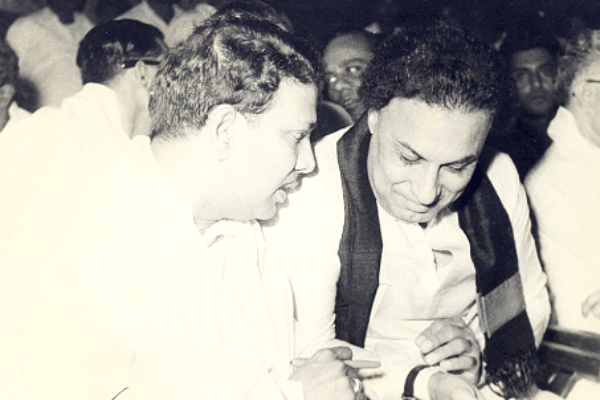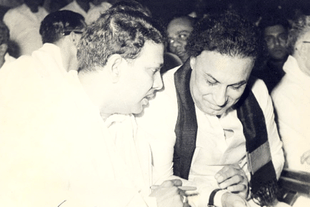Politics
History Will Be Unkind To Karunanidhi When He Is Compared With MGR
M R Subramani
Aug 07, 2018, 07:00 PM | Updated Jul 31, 2018, 01:23 PM IST
Save & read from anywhere!
Bookmark stories for easy access on any device or the Swarajya app.


Whenever the history of Tamil Nadu politics is reviewed, rewritten or discussed, Dravida Munnetra Kazhagam (DMK) patriarch M Karunanidhi and All-India Anna DMK founder M G Ramachandran (MGR) will certainly figure. In particular, some bitter truth on events that happened during their lifetime.
No doubt, the Dravidian movement gained from the sharp dialogues of Karunanidhi and the histrionics of MGR. Not that C N Annadurai, the third pillar of the Dravidian movement, was any less talented but unfortunately, he didn’t live long enough to see how it thrived, not giving any national party a semblance of chance to ascend to power in Tamil Nadu.
That leaves people to simply compare Karunanidhi and MGR and their administrations. There is no doubt that Karunanidhi is seen as one under who urban areas in Tamil Nadu saw better administration. Slum development was among the first things his administration gave priority to. On the other hand, MGR was one who paid more attention to rural Tamil Nadu since he drew his strength from the hinterland, particularly women.
History will definitely be unkind to Karunanidhi when he is compared with MGR, especially with regard to electoral fortunes. Barring the 1980 Lok Sabha elections in Tamil Nadu when the AIADMK won just two of the 39 seats at stake, Karunanidhi never tasted success against MGR at the hustings. But that result should perhaps be construed as the Tamil Nadu vote in favour of Indira Gandhi after the Janata Party couldn’t hold together to stay in power after its 1977 triumph.
A look at Dravidian history points to MGR as the primary force that made Karunanidhi the chief minister in 1969 after the death of Annadurai. MGR cast his lot with Karunanidhi to ensure that the latter and not V R Nedunchezhian, who was expected to take over the reins, became the chief minister. But the dye was cast for an imminent MGR show in the later years, historians say, which naturally led to the formation of Anna DMK after the matinee idol was expelled for seeking expenditure details of the DMK in 1971 Tamil Nadu Assembly elections.
As a newborn party, ADMK won the first election, a bypoll to Dindigul Lok Sabha in 1973, it contested. Karunanidhi was dismissive of the victory, describing it as some sort of obsession with a matinee idol. Come 1977, it turned out worse for Karunanidhi and DMK. MGR rode to power with his party triumphing in a three-cornered contest between ADMK, DMK and the Congress. ADMK and its coalition partners Communist Party of India-Marxist and Forward Bloc got the backing of 33.5 per cent of the voters.
Since MGR had aligned with the Janata Party, Karunanidhi took advantage of the situation to align with the Congress in the 1980 Lok Sabha elections. That helped the Congress-DMK alliance sweep the polls in Tamil Nadu. Since Indira Gandhi never forgave MGR for his alliance against her, she dismissed his government immediately along with a few other state governments. The dismissal only brought back MGR with an even more strong voter backing. It was perhaps the first election in Tamil Nadu that showed what a strong coalition is capable of doing.
Though the ADMK got nearly 39 per cent of the votes, its alliance with both the Communist parties, the Forward Bloc and a couple of small parties got it a whopping 48.9 per cent of the polled votes. The DMK coalition got 44.4 per cent of the votes but its own share dropped by some three percentage points from 1977 to 22.1 per cent. Congress, now nowhere near the support enjoyed then, chipped in with some 20 per cent votes.
In the 1984 elections, Tamil Nadu voters were even more harsh against the DMK. But this time, the Congress had switched over to the AIADMK camp, thus giving the alliance a clear edge. In the end, the alliance got nearly 54 per cent of the votes, while the DMK, despite seeing an improvement in its own performance, had to settle for 37 per cent for its alliance and 29 per cent for itself. But the 1984 elections is not just something of the DMK ending second-best. It was an election well-remembered for MGR winning from his bed at Brooklyn Hospital in the US.
There were two other features to this elections. Possibly, in my personal view, the election saw the birth of photo-shopping in Tamil Nadu. DMK’s official journal Murasoli carried photos of MGR in Brooklyn Hospital, telling voters that the matinee idol-turned-politician wouldn’t return to active politics again. The second, reiterated by a Dravidian movement veteran, was Karunanidhi telling the voters to give him the mandate until MGR returned from the hospital. “I will hand it over back to him,” he appealed. But there was one more statement from him to the Tamil Nadu people: “Isn’t it enough that you have punished me for so long!”. But nothing moved the voter in Tamil Nadu.
MGR died in 1987 and then the opportunity for Karunanidhi to be back in the reckoning as the state chief minister was reborn.
In between, there were efforts to merge DMK and AIADMK. Orissa stalwart Biju Patnaik was the prime mover of this effort. Dravidar Kazhagam general secretary K Veeramani, at a function, revealed this in 2009. According to Veeramani, MGR had asked the late Patnaik to find out from Karunanidhi the possibility of a merger. The conditions of the merger were that the united party would be DMK, Annadurai’s picture on the flag would stay and while MGR would be the chief minister, Karunanidhi would be the party leader.
MGR and Karunanidhi met at the government guesthouse at Chepauk and decided to come together. MGR told Karunanidhi that he would call his party’s executive council and pass a resolution on the merger. But things didn’t progress from that point and the merger never happened.
According to Panruti S Ramachandran, who was present when MGR met Karunanidhi, he and senior leader V R Nedunchezhian had talked the matinee idol out of the merger. Ramachandran told Swarajya that they pointed out to MGR that AIADMK workers would be ill-treated by DMK and they would suffer. They convinced the actor-turned-politician that at the ground level, both DMK and AIADMK workers were always at loggerheads and the merger would result in AIADMK workers losing. When the news of the MGR Fans Association chief Musiri Puthan being beaten up by DMK workers came, he was convinced that the merger would do no good to his followers and cadre.
Ramachandran says that MGR had always been “self-assured” in his dealing with Karunanidhi. He didn’t get excited nor showed any nerves. He was calm and composed, which helped him take the right decision either in favour or against Karunanidhi.
For example, in 1979, when Indira Gandhi visited Tamil Nadu, a violent group of DMK workers attacked her. Then Congress worker and now a supporter of Tamil Eelam, P Nedumaran, came to her rescue by holding pillows as a shield to protect her. When Gandhi came to Chennai as part of the visit, MGR would tolerate none of this. So, he didn’t hesitate to arrest Karunanidhi and some important DMK leaders to keep the law and order situation under control.
Karunanidhi had raised charges of corruption against MGR a few times. But the rural voters, especially, were not able to believe the charges. “Even if he has indulged in corruption, it is for us,” women in the rural areas would say, according a veteran Dravidian. But the other fact was that MGR’s charisma never faded until his death, whereas a negative image created on Karunanidhi remained in the memory of the public for long.
Various people at various times, including those who had worked with MGR, have many things to say on MGR-Karunanidhi relations. At most times, relations between them were cordial and some also say there were more interactions between them to ensure healthy politics in Tamil Nadu.
But then, when it came to electoral strategy, no doubt, MGR was always a step ahead of Karunanidhi. And in that, history will always be unkind to the tall DMK leader.
M.R. Subramani is Executive Editor, Swarajya. He tweets @mrsubramani





